Resorbable Nanomatrices from Microbial Polyhydroxyalkanoates: Design Strategy and Characterization
Abstract
1. Introduction
2. Materials and Methods
2.1. Production of PHAs
2.2. Production of Polymer Films
2.3. Production of PHA Nanomembranes by Electrostatic Spinning
2.4. A Study of PHA Films’ and Nanomembranes’ Properties
2.5. A Study of the Biological Compatibility of PHA Films and Nanomembranes in Cell Cultures In Vitro
2.6. An In Vivo Study of P(3HB-co-4HB) Films and Nanomembranes as Experimental Wound Dressings
2.7. Statistical Analysis
3. Results and Discussion
3.1. Properties of Solvent Casting PHA Films
3.2. Production and Characteristics of PHA Ultrathin Fibers by Electrostatic Spinning
3.3. A Study of the Biological Compatibility of PHA Films and Nanomembranes in Cell Cultures In Vitro
3.4. An In Vivo Study of P(3HB-co-4HB) Films and Nanomembranes as Experimental Wound Dressings
4. Conclusions
Author Contributions
Funding
Data Availability Statement
Acknowledgments
Conflicts of Interest
References
- García, M.C.; Quiroz, F. Nanostructured Polymers. In Nanobiomaterials; Elsevier: Amsterdam, The Netherlands, 2018; pp. 339–356. [Google Scholar]
- Tang, Z.; He, C.; Tian, H.; Ding, J.; Hsiao, B.S.; Chu, B.; Chen, X. Polymeric Nanostructured Materials for Biomedical Applications. Prog. Polym. Sci. 2016, 60, 86–128. [Google Scholar] [CrossRef]
- Adabi, M.; Naghibzadeh, M.; Adabi, M.; Zarrinfard, M.A.; Esnaashari, S.S.; Seifalian, A.M.; Faridi-Majidi, R.; Tanimowo Aiyelabegan, H.; Ghanbari, H. Biocompatibility and Nanostructured Materials: Applications in Nanomedicine. Artif. Cells Nanomed. Biotechnol. 2017, 45, 833–842. [Google Scholar] [CrossRef] [PubMed]
- Fratoddi, I.; Bearzotti, A.; Venditti, I.; Cametti, C.; Russo, M.V. Role of Nanostructured Polymers on the Improvement of Electrical Response-Based Relative Humidity Sensors. Sens. Actuators B Chem. 2016, 225, 96–108. [Google Scholar] [CrossRef]
- Stevanović, M. Biomedical Applications of Nanostructured Polymeric Materials. In Nanostructured Polymer Composites for Biomedical Applications; Elsevier: Amsterdam, The Netherlands, 2019; pp. 1–19. [Google Scholar]
- Koller, M. Biodegradable and Biocompatible Polyhydroxy-Alkanoates (PHA): Auspicious Microbial Macromolecules for Pharmaceutical and Therapeutic Applications. Molecules 2018, 23, 362. [Google Scholar] [CrossRef]
- Kulikouskaya, V.I.; Nikalaichuk, V.V.; Bonartsev, A.P.; Chyshankou, I.G.; Akoulina, E.A.; Demianova, I.V.; Bonartseva, G.A.; Hileuskaya, K.S.; Voinova, V.v. Fabrication of Microstructured Poly(3-Hydroxybutyrate) Films with Controlled Surface Topography. Proc. Natl. Acad. Sci. Belarus Chem. Ser. 2022, 58, 135–148. [Google Scholar] [CrossRef]
- Afshar, A.; Gultekinoglu, M.; Edirisinghe, M. Binary Polymer Systems for Biomedical Applications. Int. Mater. Rev. 2022, 1–41. [Google Scholar] [CrossRef]
- Puppi, D.; Pecorini, G.; Chiellini, F. Biomedical Processing of Polyhydroxyalkanoates. Bioengineering 2019, 6, 108. [Google Scholar] [CrossRef] [PubMed]
- Shi, J.; Votruba, A.R.; Farokhzad, O.C.; Langer, R. Nanotechnology in Drug Delivery and Tissue Engineering: From Discovery to Applications. Nano Lett. 2010, 10, 3223–3230. [Google Scholar] [CrossRef] [PubMed]
- Hench, L.; Jones, J. (Eds.) Biomaterials, Artificial Organs and Tissue Engineering; CRC Press: Boca Raton, FL, USA, 2005; ISBN 978-0-8493-2577-9. [Google Scholar]
- Nair, L.S.; Laurencin, C.T. Biodegradable Polymers as Biomaterials. Prog. Polym. Sci. 2007, 32, 762–798. [Google Scholar] [CrossRef]
- Viera Rey, D.F.; St-Pierre, J.-P. Fabrication Techniques of Tissue Engineering Scaffolds. In Handbook of Tissue Engineering Scaffolds: Volume One; Elsevier: Amsterdam, The Netherlands, 2019; pp. 109–125. [Google Scholar]
- Eltom, A.; Zhong, G.; Muhammad, A. Scaffold Techniques and Designs in Tissue Engineering Functions and Purposes: A Review. Adv. Mater. Sci. Eng. 2019, 2019, 1–13. [Google Scholar] [CrossRef]
- Nazarnezhad, S.; Baino, F.; Kim, H.-W.; Webster, T.J.; Kargozar, S. Electrospun Nanofibers for Improved Angiogenesis: Promises for Tissue Engineering Applications. Nanomaterials 2020, 10, 1609. [Google Scholar] [CrossRef] [PubMed]
- Volkov, A.V.; Muraev, A.A.; Zharkova, I.I.; Voinova, V.V.; Akoulina, E.A.; Zhuikov, V.A.; Khaydapova, D.D.; Chesnokova, D.V.; Menshikh, K.A.; Dudun, A.A.; et al. Poly(3-Hydroxybutyrate)/Hydroxyapatite/Alginate Scaffolds Seeded with Mesenchymal Stem Cells Enhance the Regeneration of Critical-Sized Bone Defect. Mater. Sci. Eng. C 2020, 114, 110991. [Google Scholar] [CrossRef] [PubMed]
- Sampath, U.; Ching, Y.; Chuah, C.; Sabariah, J.; Lin, P.-C. Fabrication of Porous Materials from Natural/Synthetic Biopolymers and Their Composites. Materials 2016, 9, 991. [Google Scholar] [CrossRef] [PubMed]
- Fitzsimmons, R.E.B.; Mazurek, M.S.; Soos, A.; Simmons, C.A. Mesenchymal Stromal/Stem Cells in Regenerative Medicine and Tissue Engineering. Stem Cells Int. 2018, 2018, 1–16. [Google Scholar] [CrossRef] [PubMed]
- Wang, M.; Chen, L.J.; Ni, J.; Weng, J.; Yue, C.Y. Manufacture and Evaluation of Bioactive and Biodegradable Materials and Scaffolds for Tissue Engineering. J. Mater. Sci. Mater. Med. 2001, 12, 855–860. [Google Scholar] [CrossRef] [PubMed]
- Velema, J.; Kaplan, D. Biopolymer-Based Biomaterials as Scaffolds for Tissue Engineering. In Tissue Engineering I; Springer: Berlin/Heidelberg, Germany, 2006; pp. 187–238. [Google Scholar]
- Hosseinkhani, H.; Hosseinkhani, M. Tissue Engineered Scaffolds for Stem Cells and Regenerative Medicine. In Trends in Stem Cell Biology and Technology; Humana Press: Totowa, NJ, USA, 2009; pp. 367–387. [Google Scholar]
- Park, J.B.; Lakes, R.S. Tissue Response to Implants. In Biomaterials; Springer New York: New York, NY, USA, 2007; pp. 265–290. [Google Scholar]
- Kulikouskaya, V.I.; Nikalaichuk, V.V.; Bonartsev, A.P.; Akoulina, E.A.; Belishev, N.V.; Demianova, I.V.; Chesnokova, D.V.; Makhina, T.K.; Bonartseva, G.A.; Shaitan, K.V.; et al. Honeycomb-Structured Porous Films from Poly(3-Hydroxybutyrate) and Poly(3-Hydroxybutyrate-Co-3-Hydroxyvalerate): Physicochemical Characterization and Mesenchymal Stem Cells Behavior. Polymers 2022, 14, 2671. [Google Scholar] [CrossRef]
- Meyer, U.; Büchter, A.; Wiesmann, H.; Joos, U.; Jones, D. Basic Reactions of Osteoblasts on Structured Material Surfaces. Eur. Cell. Mater. 2005, 9, 39–49. [Google Scholar] [CrossRef]
- Wei, J.; Yoshinari, M.; Takemoto, S.; Hattori, M.; Kawada, E.; Liu, B.; Oda, Y. Adhesion of Mouse Fibroblasts on Hexamethyldisiloxane Surfaces with Wide Range of Wettability. J. Biomed. Mater. Res. B Appl. Biomater. 2007, 81, 66–75. [Google Scholar] [CrossRef]
- Jansen, E.J.P.; Sladek, R.E.J.; Bahar, H.; Yaffe, A.; Gijbels, M.J.; Kuijer, R.; Bulstra, S.K.; Guldemond, N.A.; Binderman, I.; Koole, L.H. Hydrophobicity as a Design Criterion for Polymer Scaffolds in Bone Tissue Engineering. Biomaterials 2005, 26, 4423–4431. [Google Scholar] [CrossRef]
- Tezcaner, A.; Bugra, K.; Hasırcı, V. Retinal Pigment Epithelium Cell Culture on Surface Modified Poly(Hydroxybutyrate-Co-Hydroxyvalerate) Thin Films. Biomaterials 2003, 24, 4573–4583. [Google Scholar] [CrossRef]
- Pompe, T.; Keller, K.; Mothes, G.; Nitschke, M.; Teese, M.; Zimmermann, R.; Werner, C. Surface Modification of Poly(Hydroxybutyrate) Films to Control Cell–Matrix Adhesion. Biomaterials 2007, 28, 28–37. [Google Scholar] [CrossRef] [PubMed]
- Lucchesi, C.; Ferreira, B.M.P.; Duek, E.A.R.; Santos, A.R.; Joazeiro, P.P. Increased Response of Vero Cells to PHBV Matrices Treated by Plasma. J. Mater. Sci. Mater. Med. 2008, 19, 635–643. [Google Scholar] [CrossRef]
- Grøndahl, L.; Chandler-Temple, A.; Trau, M. Polymeric Grafting of Acrylic Acid onto Poly(3-Hydroxybutyrate- c o -3-Hydroxyvalerate): Surface Functionalization for Tissue Engineering Applications. Biomacromolecules 2005, 6, 2197–2203. [Google Scholar] [CrossRef] [PubMed]
- Hu, S.-G.; Jou, C.-H.; Yang, M.C. Protein Adsorption, Fibroblast Activity and Antibacterial Properties of Poly(3-Hydroxybutyric Acid-Co-3-Hydroxyvaleric Acid) Grafted with Chitosan and Chitooligosaccharide after Immobilized with Hyaluronic Acid. Biomaterials 2003, 24, 2685–2693. [Google Scholar] [CrossRef]
- Van den Dolder, J.; de Ruijter, A.J.E.; Spauwen, P.H.M.; Jansen, J.A. Observations on the Effect of BMP-2 on Rat Bone Marrow Cells Cultured on Titanium Substrates of Different Roughness. Biomaterials 2003, 24, 1853–1860. [Google Scholar] [CrossRef]
- Ji, G.-Z.; Wei, X.; Chen, G.-Q. Growth of Human Umbilical Cord Wharton’s Jelly-Derived Mesenchymal Stem Cells on the Terpolyester Poly(3-Hydroxybutyrate-Co-3-Hydroxyvalerate-Co-3-Hydroxyhexanoate). J. Biomater. Sci. Polym. Ed. 2009, 20, 325–339. [Google Scholar] [CrossRef]
- Gennes, P.G. Smachivanie: Statika i Dinamika. Uspekhi Fiz. Nauk 1987, 151, 619. [Google Scholar] [CrossRef]
- Ko, H.-F.; Sfeir, C.; Kumta, P.N. Novel Synthesis Strategies for Natural Polymer and Composite Biomaterials as Potential Scaffolds for Tissue Engineering. Philos. Trans. R. Soc. A Math. Phys. Eng. Sci. 2010, 368, 1981–1997. [Google Scholar] [CrossRef]
- Kroeze, R.; Helder, M.; Govaert, L.; Smit, T. Biodegradable Polymers in Bone Tissue Engineering. Materials 2009, 2, 833–856. [Google Scholar] [CrossRef]
- Chen, G.-Q. Plastics Completely Synthesized by Bacteria: Polyhydroxyalkanoates. In Plastics from Bacteria; Springer: Berlin/Heidelberg, Germany, 2010; pp. 17–37. [Google Scholar]
- Sudesh, K.; Abe, H. Practical Guide to Microbial Polyhydroxyalkanoates; ISmithers: Shropshire, UK, 2010; ISBN 9781847351180. [Google Scholar]
- Laycock, B.; Halley, P.; Pratt, S.; Werker, A.; Lant, P. The Chemomechanical Properties of Microbial Polyhydroxyalkanoates. Prog. Polym. Sci. 2013, 38, 536–583. [Google Scholar] [CrossRef]
- Volova, T.G.; Shishatskaya, E.; Sinskey, A.J. Degradable Polymers: Production, Properties, Applications; Nova Science Publishers, Inc.: Hauppauge, NY, USA, 2013; pp. 1–380. [Google Scholar]
- Chen, G.-Q.; Chen, X.-Y.; Wu, F.-Q.; Chen, J.-C. Polyhydroxyalkanoates (PHA) toward Cost Competitiveness and Functionality. Adv. Ind. Eng. Polym. Res. 2020, 3, 1–7. [Google Scholar] [CrossRef]
- Mitra, R.; Xu, T.; Chen, G.; Xiang, H.; Han, J. An Updated Overview on the Regulatory Circuits of Polyhydroxyalkanoates Synthesis. Microb. Biotechnol. 2022, 15, 1446–1470. [Google Scholar] [CrossRef] [PubMed]
- Tan, D.; Wang, Y.; Tong, Y.; Chen, G.-Q. Grand Challenges for Industrializing Polyhydroxyalkanoates (PHAs). Trends Biotechnol. 2021, 39, 953–963. [Google Scholar] [CrossRef] [PubMed]
- Koller, M.; Mukherjee, A. A New Wave of Industrialization of PHA Biopolyesters. Bioengineering 2022, 9, 74. [Google Scholar] [CrossRef]
- Tarrahi, R.; Fathi, Z.; Seydibeyoğlu, M.Ö.; Doustkhah, E.; Khataee, A. Polyhydroxyalkanoates (PHA): From Production to Nanoarchitecture. Int. J. Biol. Macromol. 2020, 146, 596–619. [Google Scholar] [CrossRef]
- Kalia, V.C. (Ed.) Biotechnological Applications of Polyhydroxyalkanoates; Springer Singapore: Singapore, 2019; ISBN 978-981-13-3758-1. [Google Scholar]
- Popa, M.S.; Frone, A.N.; Panaitescu, D.M. Polyhydroxybutyrate Blends: A Solution for Biodegradable Packaging? Int. J. Biol. Macromol. 2022, 207, 263–277. [Google Scholar] [CrossRef]
- Koller, M.; Mukherjee, A. Polyhydroxyalkanoates—Linking Properties, Applications and End-of-Life Options. Chem. Biochem. Eng. Q. 2020, 34, 115–129. [Google Scholar] [CrossRef]
- Polyhydroxyalkanoate (PHA) Market by Type (Short Chain Length, Medium Chain Length), Production Method (Sugar Fermentation, Vegetable Oil Fermentation), Application (Packaging & Food Services, Biomedical) and Region—Global Forecast to 2027. Available online: https://www.marketsandmarkets.com/Market-Reports/pha-market-395.html (accessed on 20 September 2022).
- Dalton, B.; Bhagabati, P.; de Micco, J.; Padamati, R.B.; O’Connor, K. A Review on Biological Synthesis of the Biodegradable Polymers Polyhydroxyalkanoates and the Development of Multiple Applications. Catalysts 2022, 12, 319. [Google Scholar] [CrossRef]
- Palmeiro-Sánchez, T.; O’Flaherty, V.; Lens, P.N.L. Polyhydroxyalkanoate Bio-Production and Its Rise as Biomaterial of the Future. J. Biotechnol. 2022, 348, 10–25. [Google Scholar] [CrossRef]
- Adeleye, A.T.; Odoh, C.K.; Enudi, O.C.; Banjoko, O.O.; Osiboye, O.O.; Toluwalope Odediran, E.; Louis, H. Sustainable Synthesis and Applications of Polyhydroxyalkanoates (PHAs) from Biomass. Process Biochem. 2020, 96, 174–193. [Google Scholar] [CrossRef]
- Chen, G.-Q.; Wu, Q. The Application of Polyhydroxyalkanoates as Tissue Engineering Materials. Biomaterials 2005, 26, 6565–6578. [Google Scholar] [CrossRef] [PubMed]
- Volova, T.G.; Vinnik, Y.S.; Shishatskaya, E.I.; Markelova, N.M.; Zaikov, G.E. Natural-Based Polymers for Biomedical Applications; Apple Academic Press: New York, NY, USA, 2017. [Google Scholar]
- Guo, W.; Yang, K.; Qin, X.; Luo, R.; Wang, H.; Huang, R. Polyhydroxyalkanoates in Tissue Repair and Regeneration. Eng. Regen. 2022, 3, 24–40. [Google Scholar] [CrossRef]
- Singh, A.K.; Srivastava, J.K.; Chandel, A.K.; Sharma, L.; Mallick, N.; Singh, S.P. Biomedical Applications of Microbially Engineered Polyhydroxyalkanoates: An Insight into Recent Advances, Bottlenecks, and Solutions. Appl. Microbiol. Biotechnol. 2019, 103, 2007–2032. [Google Scholar] [CrossRef] [PubMed]
- Asare, E.; Gregory, D.A.; Fricker, A.; Marcello, E.; Paxinou, A.; Taylor, C.S.; Haycock, J.W.; Roy, I. Polyhydroxyalkanoates, Their Processing and Biomedical Applications. In The Handbook of Polyhydroxyalkanoates; CRC Press: Boca Raton, FL, USA, 2020; pp. 255–284. [Google Scholar]
- Philip, S.; Keshavarz, T.; Roy, I. Polyhydroxyalkanoates: Biodegradable Polymers with a Range of Applications. J. Chem. Technol. Biotechnol. 2007, 82, 233–247. [Google Scholar] [CrossRef]
- Sharma, V.; Sehgal, R.; Gupta, R. Polyhydroxyalkanoate (PHA): Properties and Modifications. Polymer 2021, 212, 123161. [Google Scholar] [CrossRef]
- Singh, M.; Kumar, P.; Ray, S.; Kalia, V.C. Challenges and Opportunities for Customizing Polyhydroxyalkanoates. Indian J. Microbiol. 2015, 55, 235–249. [Google Scholar] [CrossRef]
- Li, Z.; Yang, J.; Loh, X.J. Polyhydroxyalkanoates: Opening Doors for a Sustainable Future. NPG Asia Mater. 2016, 8, e265. [Google Scholar] [CrossRef]
- Anjum, A.; Zuber, M.; Zia, K.M.; Noreen, A.; Anjum, M.N.; Tabasum, S. Microbial Production of Polyhydroxyalkanoates (PHAs) and Its Copolymers: A Review of Recent Advancements. Int. J. Biol. Macromol. 2016, 89, 161–174. [Google Scholar] [CrossRef]
- Riveiro, A.; Maçon, A.L.B.; del Val, J.; Comesaña, R.; Pou, J. Laser Surface Texturing of Polymers for Biomedical Applications. Front. Phys. 2018, 6, 16. [Google Scholar] [CrossRef]
- Slepicka, P.; Michaljanicova, I.; Svorcik, V. Control.lled Biopolymer Roughness Induced by Plasma and Excimer Laser Treatment. Express Polym. Lett. 2013, 7, 950–958. [Google Scholar] [CrossRef]
- Ortiz, R.; Aurrekoetxea-Rodríguez, I.; Rommel, M.; Quintana, I.; Vivanco, M.; Toca-Herrera, J. Laser Surface Microstructuring of a Bio-Resorbable Polymer to Anchor Stem Cells, Control Adipocyte Morphology, and Promote Osteogenesis. Polymers 2018, 10, 1337. [Google Scholar] [CrossRef] [PubMed]
- Volova, T.; Kiselev, E.; Nemtsev, I.; Lukyanenko, A.; Sukovatyi, A.; Kuzmin, A.; Ryltseva, G.; Shishatskaya, E. Properties of Degradable Polyhydroxyalkanoates with Different Monomer Compositions. Int. J. Biol. Macromol. 2021, 182, 98–114. [Google Scholar] [CrossRef] [PubMed]
- Braunegg, G.; Sonnleitner, B.; Lafferty, R.M. A Rapid Gas Chromatographic Method for the Determination of Poly-?-Hydroxybutyric Acid in Microbial Biomass. Eur. J. Appl. Microbiol. Biotechnol. 1978, 6, 29–37. [Google Scholar] [CrossRef]
- ISO 468:1982; Surface Roughness—Parameters, Their Values and General Rules for Specifying Requirements. International Organization for Standardization: Geneva, Switzerland, 1982.
- GOST R ISO:10993-1-2009; Medical Products. Estimating Biological Effects of Medical Products. International Organization for Standardization: Geneva, Switzerland, 2009.
- International Guiding Principles for Biomedical Research Involving Animals; CIOMS: Geneva, Switzerland, 1985; 28p.
- Declaration of Helsinki on Treating Research Animals with Respect; WMA: Ferney-Voltaire, France, 2000.
- European Convention for the Protection of Vertebrate Animals Used for Experimental and Other Scientific Purposes; Biolaw Microfiche Supplement; European Union: Luxembourg, 1986.
- Surguchenko, V.A.; Ponomareva, A.S.; Efimov, A.E.; Nemets, E.A.; Agapov, I.; Sevastianov, V. Characteristics of adhesion and proliferation of mouse NIH/3T3 fibroblasts on the poly(3-hydroxybutyrate-co-3-hydroxyvalerate) films with different surface roughness values. Vestn. Transpl. I Iskusstv. Organov 2012, 14, 72–77. [Google Scholar] [CrossRef]
- Bera, P.; Kotamreddy, J.N.R.; Samanta, T.; Maiti, S.; Mitra, A. Inter-Specific Variation in Headspace Scent Volatiles Composition of Four Commercially Cultivated Jasmine Flowers. Nat. Prod. Res. 2015, 29, 1328–1335. [Google Scholar] [CrossRef]
- Chanprateep, S. Current Trends in Biodegradable Polyhydroxyalkanoates. J. Biosci. Bioeng. 2010, 110, 621–632. [Google Scholar] [CrossRef]
- Zhang, J.; Shishatskaya, E.I.; Volova, T.G.; da Silva, L.F.; Chen, G.-Q. Polyhydroxyalkanoates (PHA) for Therapeutic Applications. Mater. Sci. Eng. C 2018, 86, 144–150. [Google Scholar] [CrossRef]
- Wang, Y.-W.; Wu, Q.; Chen, G.-Q. Attachment, Proliferation and Differentiation of Osteoblasts on Random Biopolyester Poly(3-Hydroxybutyrate-Co-3-Hydroxyhexanoate) Scaffolds. Biomaterials 2004, 25, 669–675. [Google Scholar] [CrossRef]
- Wang, Y.-W.; Yang, F.; Wu, Q.; Cheng, Y.; Yu, P.H.F.; Chen, J.; Chen, G.-Q. Effect of Composition of Poly(3-Hydroxybutyrate-Co-3-Hydroxyhexanoate) on Growth of Fibroblast and Osteoblast. Biomaterials 2005, 26, 755–761. [Google Scholar] [CrossRef]
- Taylor, G. Electrically Driven Jets. Proc. R. Soc. Lond. A Math. Phys. Sci. 1969, 313, 453–475. [Google Scholar] [CrossRef]
- Volova, T.G.; Shishatskaya, E.I.; Gordeev, S.A. Characterization of Ultrafine Fibers Electrostatically Spun from Poly(Hydroxybutyrate/Hydroxyvalerate) Solutions: Scientific Publication. Perspektivnye Materialy 2006, 3, 25–29. [Google Scholar]
- Tong, H.-W.; Wang, M. Electrospinning of Aligned Biodegradable Polymer Fibers and Composite Fibers for Tissue Engineering Applications. J. Nanosci. Nanotechnol. 2007, 7, 3834–3840. [Google Scholar] [CrossRef] [PubMed]
- Tong, H.-W.; Wang, M. Electrospinning of Poly(Hydroxybutyrate- Co -Hydroxyvalerate) Fibrous Scaffolds for Tissue Engineering Applications: Effects of Electrospinning Parameters and Solution Properties. J. Macromol. Sci. Part B 2011, 50, 1535–1558. [Google Scholar] [CrossRef]
- Volova, T.; Goncharov, D.; Sukovatyi, A.; Shabanov, A.; Nikolaeva, E.; Shishatskaya, E. Electrospinning of Polyhydroxyalkanoate Fibrous Scaffolds: Effects on Electrospinning Parameters on Structure and Properties. J. Biomater. Sci. Polym. Ed. 2014, 25, 370–393. [Google Scholar] [CrossRef]
- Wang, Y.; Gao, R.; Wang, P.-P.; Jian, J.; Jiang, X.-L.; Yan, C.; Lin, X.; Wu, L.; Chen, G.-Q.; Wu, Q. The Differential Effects of Aligned Electrospun PHBHHx Fibers on Adipogenic and Osteogenic Potential of MSCs through the Regulation of PPARγ Signaling. Biomaterials 2012, 33, 485–493. [Google Scholar] [CrossRef]
- Yu, B.-Y.; Chen, P.-Y.; Sun, Y.-M.; Lee, Y.-T.; Young, T.-H. Response of Human Mesenchymal Stem Cells (HMSCs) to the Topographic Variation of Poly(3-Hydroxybutyrate-Co-3-Hydroxyhexanoate) (PHBHHx) Films. J. Biomater. Sci. Polym. Ed. 2012, 23, 1–26. [Google Scholar] [CrossRef]
- Wong, S.-C.; Baji, A.; Leng, S. Effect of Fiber Diameter on Tensile Properties of Electrospun Poly(ε-Caprolactone). Polymer 2008, 49, 4713–4722. [Google Scholar] [CrossRef]
- Baji, A.; Mai, Y.-W.; Wong, S.-C.; Abtahi, M.; Chen, P. Electrospinning of Polymer Nanofibers: Effects on Oriented Morphology, Structures and Tensile Properties. Compos. Sci. Technol. 2010, 70, 703–718. [Google Scholar] [CrossRef]
- Baker, S.C.; Atkin, N.; Gunning, P.A.; Granville, N.; Wilson, K.; Wilson, D.; Southgate, J. Characterisation of Electrospun Polystyrene Scaffolds for Three-Dimensional in Vitro Biological Studies. Biomaterials 2006, 27, 3136–3146. [Google Scholar] [CrossRef]
- Wang, C.; Chien, H.-S.; Yan, K.-W.; Hung, C.-L.; Hung, K.-L.; Tsai, S.-J.; Jhang, H.-J. Correlation between Processing Parameters and Microstructure of Electrospun Poly(D,l-Lactic Acid) Nanofibers. Polymer 2009, 50, 6100–6110. [Google Scholar] [CrossRef]
- Li, Q.; Yang, Y.; Jia, Z.; Guan, Z. Experimental Investigation of the Effect of Processing Parameters on the Formation of Electrospun Polyethylene Oxide Nanofibers. Gaodianya Jishu High Volt. Eng. 2007, 33, 186–189. [Google Scholar]
- Cheng, M.-L.; Lin, C.-C.; Su, H.-L.; Chen, P.-Y.; Sun, Y.-M. Processing and Characterization of Electrospun Poly(3-Hydroxybutyrate-Co-3-Hydroxyhexanoate) Nanofibrous Membranes. Polymer 2008, 49, 546–553. [Google Scholar] [CrossRef]
- Yördem, O.S.; Papila, M.; Menceloğlu, Y.Z. Effects of Electrospinning Parameters on Polyacrylonitrile Nanofiber Diameter: An Investigation by Response Surface Methodology. Mater. Des. 2008, 29, 34–44. [Google Scholar] [CrossRef]
- Huang, Z.-M.; Zhang, Y.-Z.; Kotaki, M.; Ramakrishna, S. A Review on Polymer Nanofibers by Electrospinning and Their Applications in Nanocomposites. Compos. Sci. Technol. 2003, 63, 2223–2253. [Google Scholar] [CrossRef]
- Kenawy, E.-R.; Layman, J.M.; Watkins, J.R.; Bowlin, G.L.; Matthews, J.A.; Simpson, D.G.; Wnek, G.E. Electrospinning of Poly(Ethylene-Co-Vinyl Alcohol) Fibers. Biomaterials 2003, 24, 907–913. [Google Scholar] [CrossRef]
- Kessick, R.; Fenn, J.; Tepper, G. The Use of AC Potentials in Electrospraying and Electrospinning Processes. Polymer 2004, 45, 2981–2984. [Google Scholar] [CrossRef]
- Khil, M.S.; Kim, H.Y.; Kim, M.S.; Park, S.Y.; Lee, D.-R. Nanofibrous Mats of Poly(Trimethylene Terephthalate) via Electrospinning. Polymer 2004, 45, 295–301. [Google Scholar] [CrossRef]
- Mo, X.M.; Xu, C.Y.; Kotaki, M.; Ramakrishna, S. Electrospun P(LLA-CL) Nanofiber: A Biomimetic Extracellular Matrix for Smooth Muscle Cell and Endothelial Cell Proliferation. Biomaterials 2004, 25, 1883–1890. [Google Scholar] [CrossRef]
- Theron, S.A.; Zussman, E.; Yarin, A.L. Experimental Investigation of the Governing Parameters in the Electrospinning of Polymer Solutions. Polymer 2004, 45, 2017–2030. [Google Scholar] [CrossRef]
- Riboldi, S.A.; Sampaolesi, M.; Neuenschwander, P.; Cossu, G.; Mantero, S. Electrospun Degradable Polyesterurethane Membranes: Potential Scaffolds for Skeletal Muscle Tissue Engineering. Biomaterials 2005, 26, 4606–4615. [Google Scholar] [CrossRef]
- Sombatmankhong, K.; Sanchavanakit, N.; Pavasant, P.; Supaphol, P. Bone Scaffolds from Electrospun Fiber Mats of Poly(3-Hydroxybutyrate), Poly(3-Hydroxybutyrate-Co-3-Hydroxyvalerate) and Their Blend. Polymer 2007, 48, 1419–1427. [Google Scholar] [CrossRef]
- Ying, T.H.; Ishii, D.; Mahara, A.; Murakami, S.; Yamaoka, T.; Sudesh, K.; Samian, R.; Fujita, M.; Maeda, M.; Iwata, T. Scaffolds from Electrospun Polyhydroxyalkanoate Copolymers: Fabrication, Characterization, Bioabsorption and Tissue Response. Biomaterials 2008, 29, 1307–1317. [Google Scholar] [CrossRef] [PubMed]
- Ishii, D.; Ying, T.; Yamaoka, T.; Iwata, T. Characterization and Biocompatibility of Biopolyester Nanofibers. Materials 2009, 2, 1520–1546. [Google Scholar] [CrossRef]
- Bashur, C.A.; Dahlgren, L.A.; Goldstein, A.S. Effect of Fiber Diameter and Orientation on Fibroblast Morphology and Proliferation on Electrospun Poly(d,l-Lactic-Co-Glycolic Acid) Meshes. Biomaterials 2006, 27, 5681–5688. [Google Scholar] [CrossRef]
- Pham, Q.P.; Sharma, U.; Mikos, A.G. Electrospinning of Polymeric Nanofibers for Tissue Engineering Applications: A Review. Tissue Eng. 2006, 12, 1197–1211. [Google Scholar] [CrossRef]
- Sill, T.J.; von Recum, H.A. Electrospinning: Applications in Drug Delivery and Tissue Engineering. Biomaterials 2008, 29, 1989–2006. [Google Scholar] [CrossRef]
- Lowery, J.L.; Datta, N.; Rutledge, G.C. Effect of Fiber Diameter, Pore Size and Seeding Method on Growth of Human Dermal Fibroblasts in Electrospun Poly(ε-Caprolactone) Fibrous Mats. Biomaterials 2010, 31, 491–504. [Google Scholar] [CrossRef]
- Minchenko, A. Wounds. Treatment and Prevention of Complications; SpecLit: St. Petersburg, Russia, 2003; Volume 206. [Google Scholar]
- Abayev, Y.K. Surgeon Reference Book. Wounds and Wound Infection; Feniks: Moskow, Russia, 2006; Volume 427. [Google Scholar]
- Adamyan, A.A.; Dobysh, S.v; Kilimchuk, L.E.; Goryunov, S.v; Efimenko, N.A.; Shibanov, E.A.; Khrupkin, V.I.; Leshnevskii, A.v; Emel’yanov, A.v; Nuzhdin, O.I.; et al. Biologically Active Dressings in the Complex. Treatment of Purulent-Necrotic Wounds; Fedorov, V.D., Chizh, I.M., Eds.; Ministry of Public Health: Moscow, Russia, 2000.
- FDA Clears First of Its Kind Suture Made Using DNA Technology. Available online: http://www.fda.gov/bbs/topics/NEWS/2007/NEW01560.html (accessed on 25 April 2020).
- Martin, D.P.; Skraly, F.A.; Williams, S.F. Polyhydroxyalkanoate Compositions Having Controlled Degradation Rats. U.S. Patent US20030236320A1, 12 April 2005. [Google Scholar]
- Shishatskaya, E.I.; Nikolaeva, E.D.; Vinogradova, O.N.; Volova, T.G. Experimental Wound Dressings of Degradable PHA for Skin Defect Repair. J. Mater. Sci. Mater. Med. 2016, 27, 165. [Google Scholar] [CrossRef]
- Volova, T.G.; Shumilova, A.A.; Nikolaeva, E.D.; Kirichenko, A.K.; Shishatskaya, E.I. Biotechnological Wound Dressings Based on Bacterial Cellulose and Degradable Copolymer P(3HB/4HB). Int. J. Biol. Macromol. 2019, 131, 230–240. [Google Scholar] [CrossRef]
- Guo, W.; Wang, X.; Yang, C.; Huang, R.; Wang, H.; Zhao, Y. Microfluidic 3D Printing Polyhydroxyalkanoates-Based Bionic Skin for Wound Healing. Mater. Futures 2022, 1, 015401. [Google Scholar] [CrossRef]
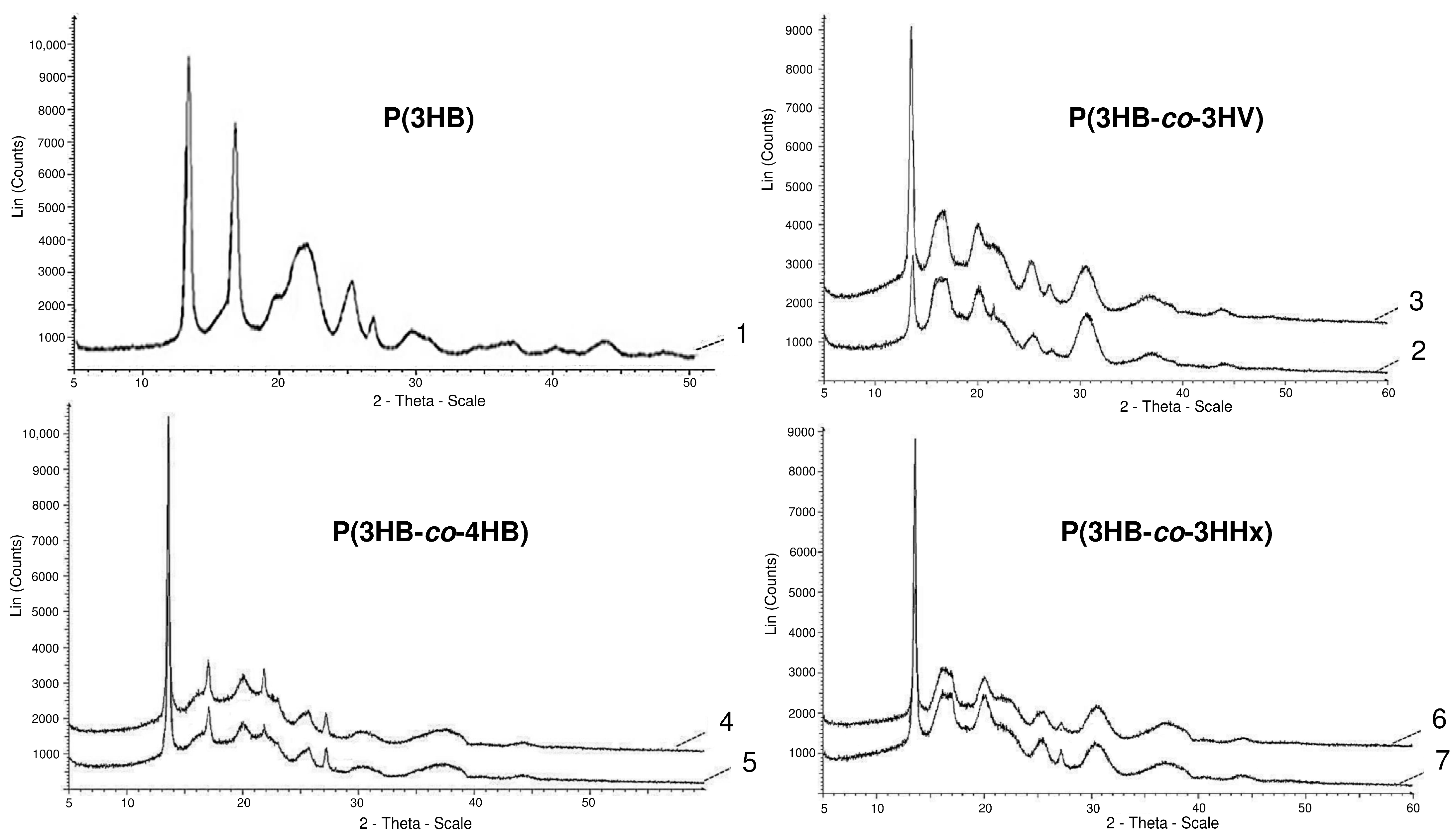
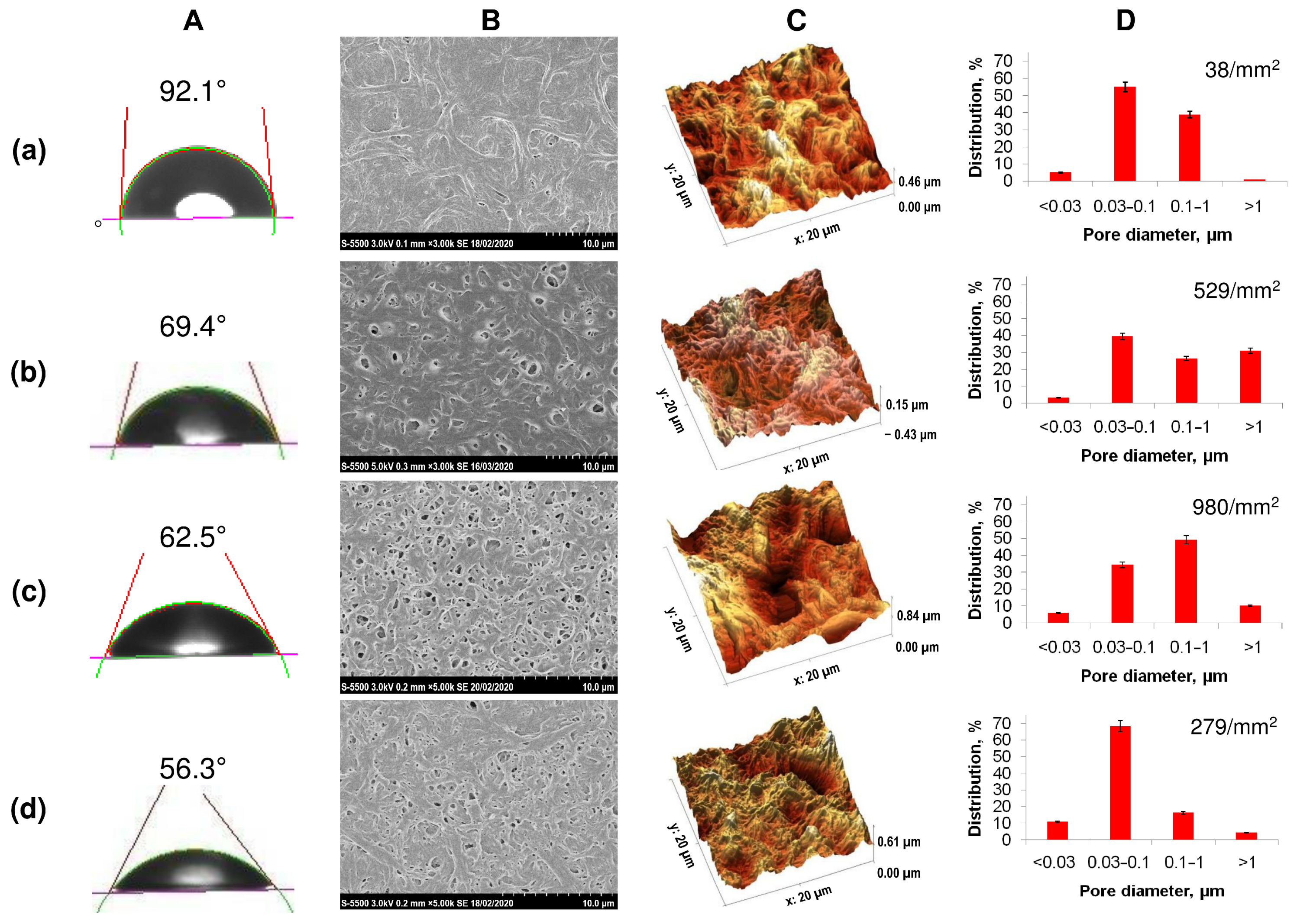
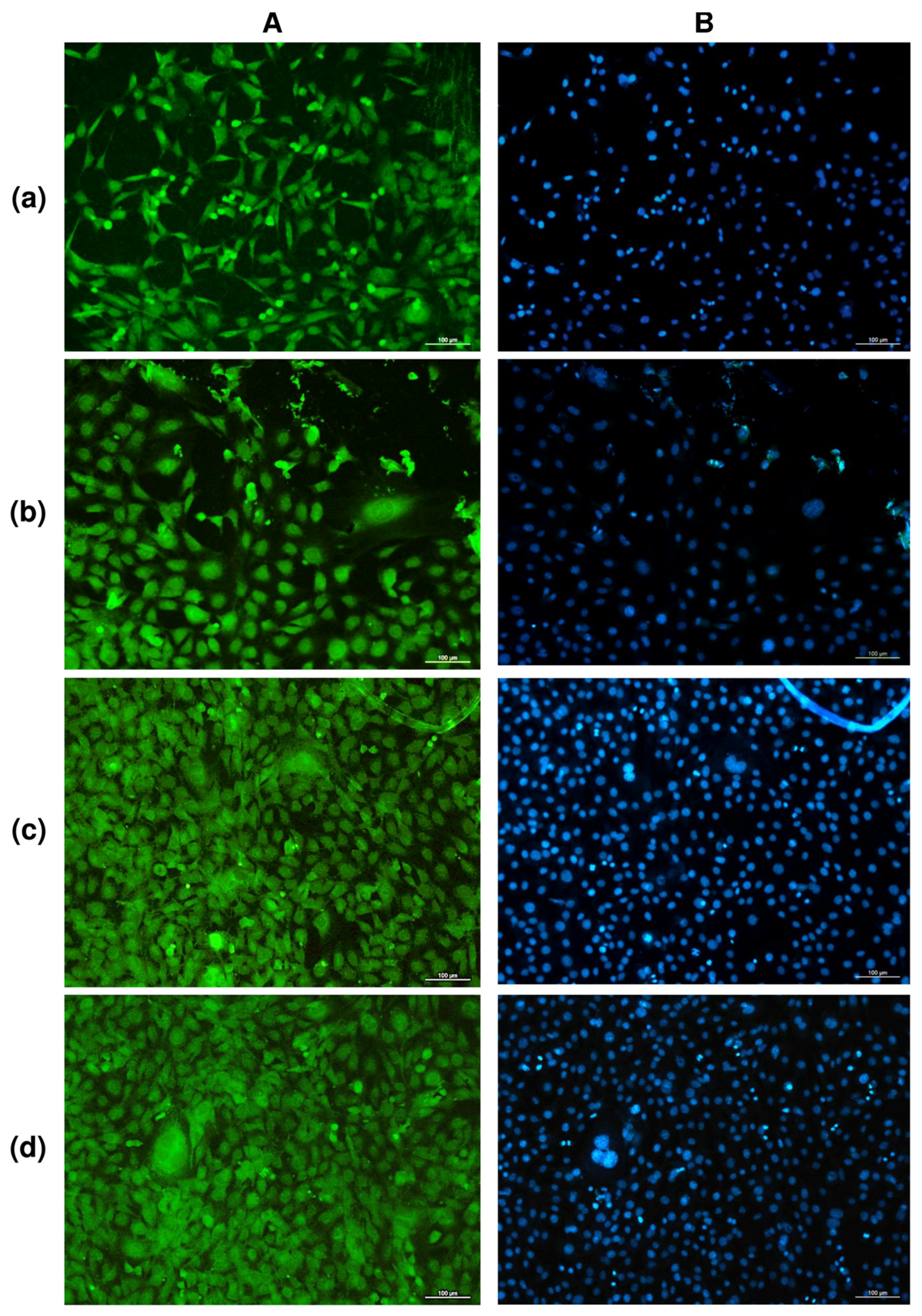
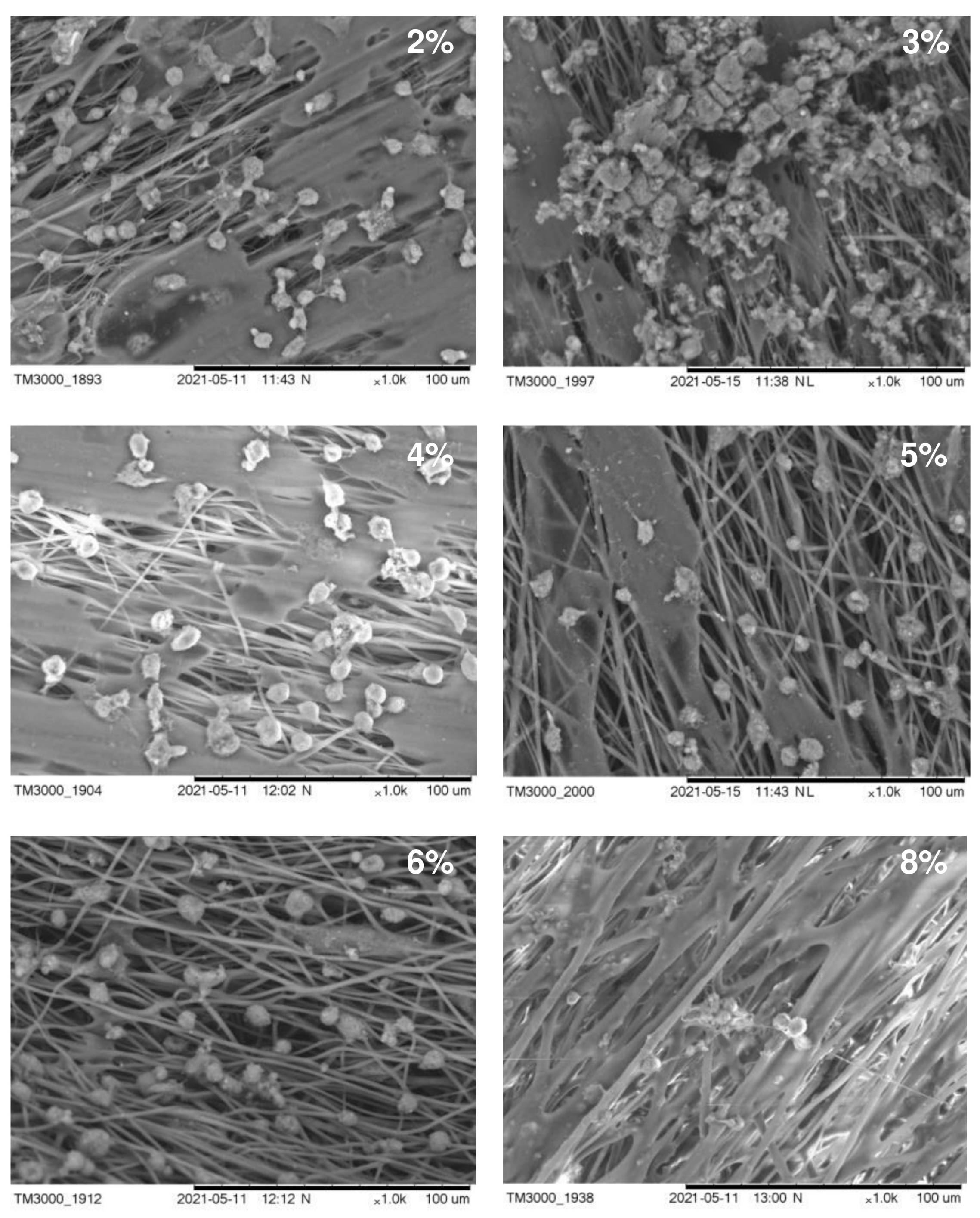
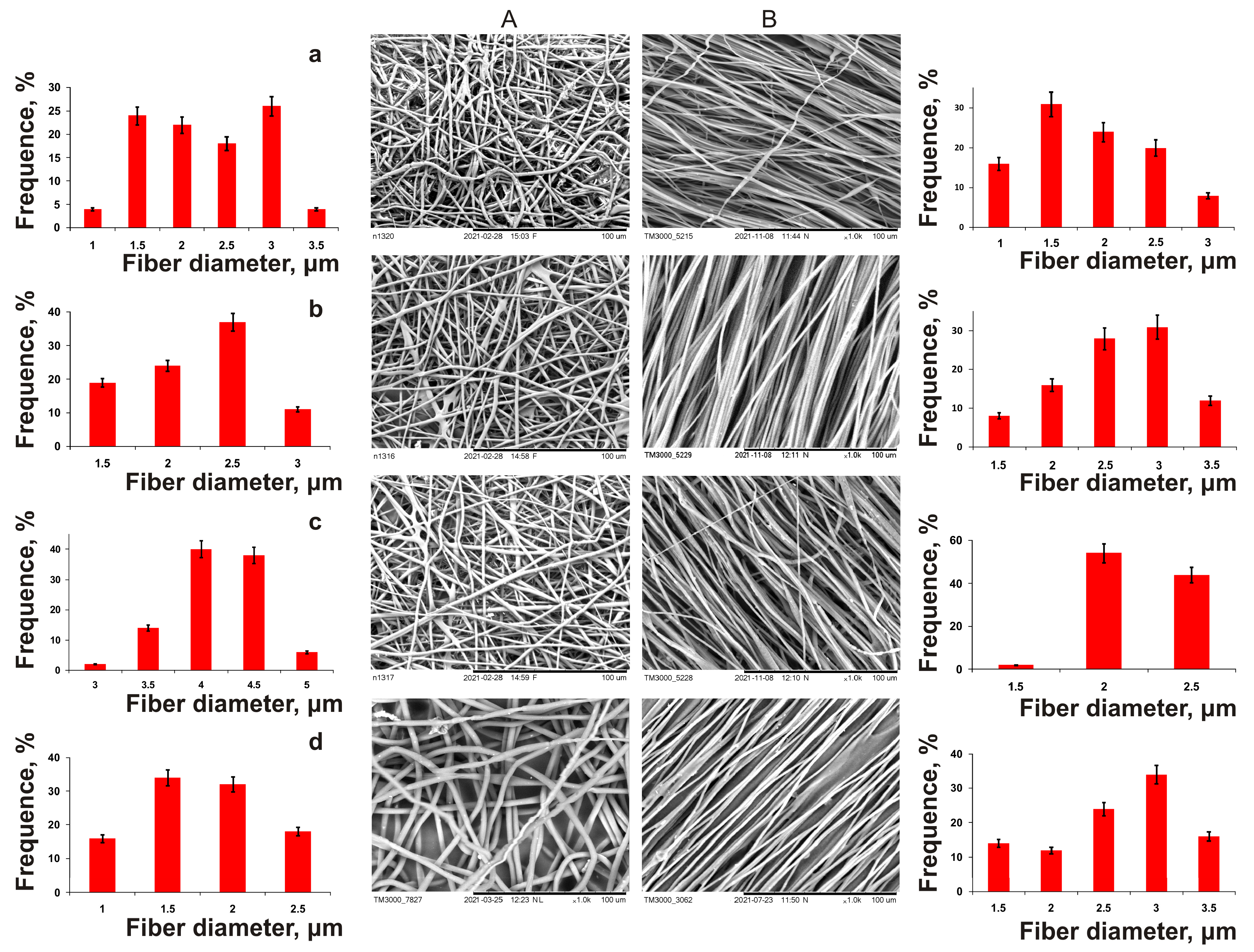
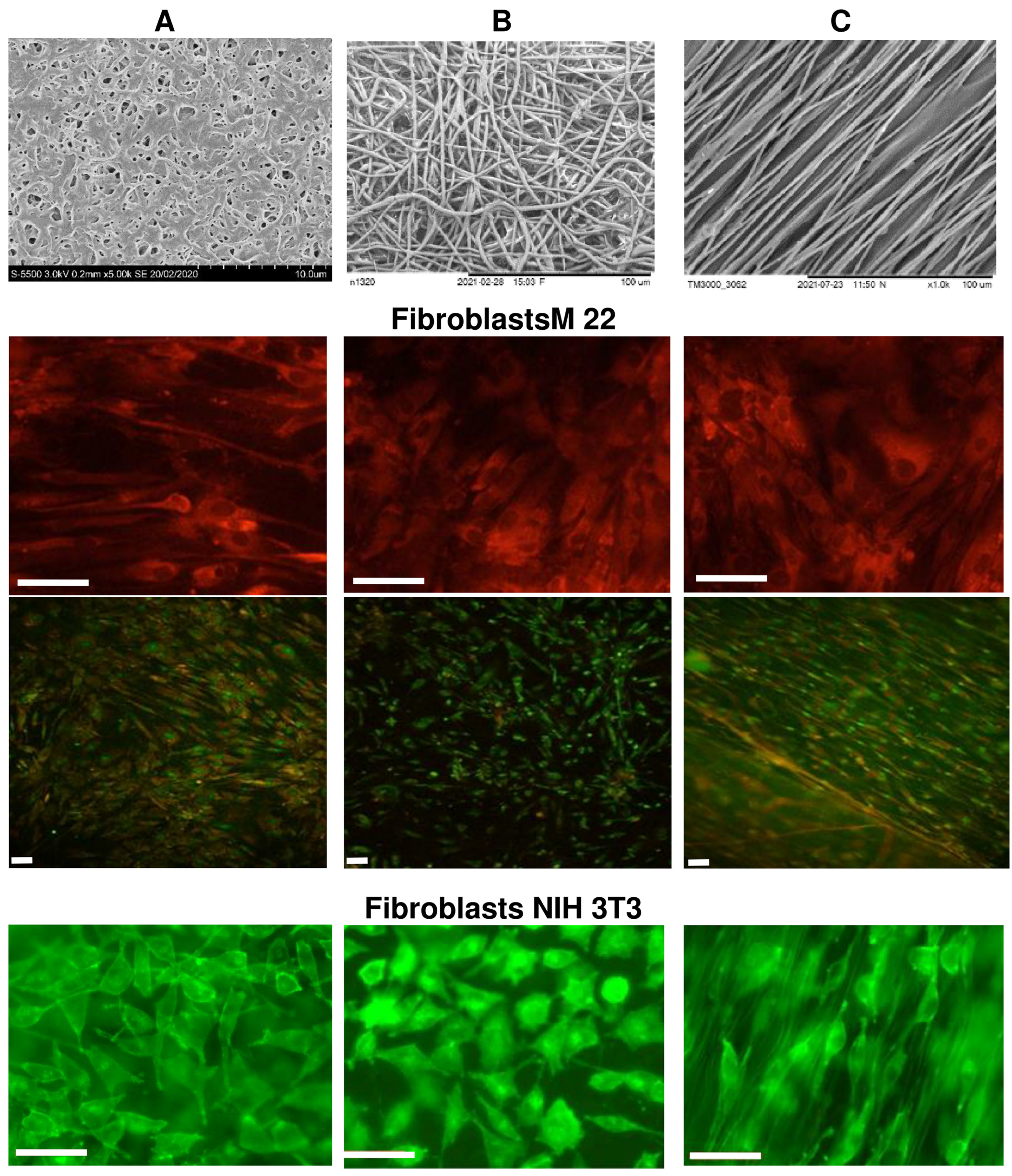

| Sample | PHA Composition (mol.%) | Average Molecular Weight Mw (kDa) | Polydispersity Ð | Degree of Crystallinity Cx (%) | Glass Transition Temperature Tg (°C) | Crystallization Temperature Tc (°C) | Melting Temperature Tmelt (°C) | Thermal Degradation Temperature Tdegr (°C) | |
|---|---|---|---|---|---|---|---|---|---|
| P(3HB)—3-hydroxybutyrate homopolymer | |||||||||
| 1 | 100.0 | 860 | 2.5 | 78 | - | 85 | 176.3 | 280.2 | |
| Copolymers: | |||||||||
| P(3HB-co-3HV) | |||||||||
| 2 | 89.5 | 10.5 | 467 | 1.8 | 60 | −1.0 | 64.2 | 175.1 | 283.9 |
| 3 | 72.8 | 32.2 | 576 | 3.2 | 58 | −1.9 | 78.1 | 162.5 | 275.9 |
| P(3HB-co-4HB) | |||||||||
| 4 | 90.0 | 10.0 | 262 | 3.1 | 50 | −11.7 | 68.2 | 161.4 | 268.0 |
| 5 | 64.5 | 35.5 | 660 | 3.6 | 26 | −9.5 | 58.5 | 165.5 | 278.4 |
| P(3HB-co-3HHx) | |||||||||
| 6 | 90.0 | 10.0 | 470 | 2.9 | 60 | −0.2 | 63.2 | 170.2 | 262.7 |
| 7 | 62.0 | 38.0 | 486 | 3.7 | 52 | −1.6 | 71.2 | 169.2 | 260.1 |
| Sample | PHA Composition (mol.%) | Water Contact Angle, ° | Surface Energy, mN/m | Interfacial Free Energy, γSL, erg/cm2 | Cohesive Force, WSL, erg/cm2 | Arithmetic Mean Surface Roughness, (Sa) nm | Root Mean Square Roughness, (Sq) nm | Peak-to-Valley Height, (Sz) nm | |
|---|---|---|---|---|---|---|---|---|---|
| P(3HB)—homopolymer poly-3-hydroxybutyrate | |||||||||
| 1 | 100.0 | 92.1 ± 6.33 | 30.8 ± 0.53 | 8.92 | 94.74 | 154.0 | 180.1 | 1255.9 | |
| Copolymers: | |||||||||
| P(3HB-co-3HV) | |||||||||
| 2 | 89.5 | 10.5 | 64.6 ± 4.1 | 49.6 ± 1.27 | 2.23 | 120.23 | 297.0 | 367.4 | 2355.4 |
| 3 | 67.8 | 32.2 | 69.4 ± 9.4 | 50.8 ± 2.64 | 1.98 | 121.70 | 206.8 | 254.1 | 1594.7 |
| P(3HB-co-4HB) | |||||||||
| 4 | 90.0 | 10.0 | 73.2 ± 4.62 | 41.5 ± 0.89 | 4.38 | 109.98 | 243.1 | 302.5 | 1900.8 |
| 5 | 64.5 | 35.5 | 62.5 ± 5.33 | 44.9 ± 0.52 | 3.37 | 114.39 | 290.1 | 370.4 | 2321.3 |
| P(3HB-co-3HHx) | |||||||||
| 6 | 90.0 | 10.0 | 71.5 ± 1.91 | 48.8 ± 2.44 | 2.40 | 119.28 | 93.7 | 118.2 | 880.6 |
| 7 | 62.0 | 38.0 | 56.3 ± 6.16 | 57.1 ± 2.89 | 0.96 | 129.02 | 172.4 | 222.4 | 1677.8 |
| PHA Composition, mol.% | Surface Properties | Physical and Mechanical Properties | |||||
|---|---|---|---|---|---|---|---|
| Water Contact Angle (θ, °) | Free Surface Energy (γS) (erg/cm2) | Free Interface Energy (γSL) (erg/cm2) | Cohesive Force (WSL) (erg/cm2) | Tensile Strength (MPa) | Young’s Modulus (MPa) | Elongation at Break (%) | |
| Nanomembranes composed of random ultrafine fibers | |||||||
| P(3HB) (100mol.%) | 64.33 ± 1.71 | 37.38 | 5.85 | 104.34 | 356.23 ± 40.62 | 9.32 ± 2.54 | 13.3 ± 3.11 |
| P(3HB-co-10.5 mol.% 3HV) | 67.17 ± 1.12 | 35.20 | 6.76 | 101.25 | 5.81 ± 1.06 | 0.67 ± 0.06 | 40.72 ± 6.20 |
| P(3HB-co-32.2 mol.% 3HV) | 72.63 ± 0.81 | 30.71 | 8.94 | 94.57 | 13.91 ± 2.07 | 0.80 ± 0.09 | 38.33 ± 5.34 |
| P(3HB-co-10.0 mol.% 4HB) | 72.12 ± 0.55 | 31.19 | 8.69 | 95.30 | 1.59 ± 0.30 | 0.42 ± 0.08 | 172.98 ± 10.33 |
| P(3HB-co-35.5 mol.% 4HB) | 73.23 ± 0.42 | 30.24 | 9.20 | 93.84 | 1.22 ± 0.36 | 1.46 ± 0.21 | 177.74 ± 20.67 |
| P(3HB-co-10.0 mol.% 3HHx) | 74.72 ± 1.35 | 29.07 | 9.86 | 92.01 | 18.68 ± 2.85 | 0.76 ± 0.10 | 69.45 ± 4.61 |
| P(3HB-co-38.0 mol.% 3HHx) | 69.85 ± 0.87 | 33.58 | 7.49 | 98.89 | 26.12 ± 3.48 | 0.78 ± 0.18 | 89.59 ± 7.13 |
| Nanomembranes composed of aligned ultrafine fibers | |||||||
| P(3HB) (100) | 69.16 ± 1.10 | 34.26 | 6.79 | 103.50 | 525.81 ± 1.06 | 15.17 ± 2.33 | 19.90 ± 3.21 |
| P(3HB-co-10.5 mol.% 3HV) | 76.72 ± 1.35 | 33.07 | 10.36 | 102.01 | 263.52 ± 49.08 | 12.26 ± 2.65 | 51.56 ± 2.10 |
| P(3HB-co-32.2 mol.% 3HV) | 69.72 ± 1.35 | 31.17 | 12.40 | 101.41 | 321.90 ± 27.33 | 14.13 ± 2.05 | 91.16 ± 7.32 |
| P(3HB-co-10.0 mol.% 4HB) | 72.12 ± 1.05 | 32.04 | 14.06 | 98.01 | 143.70 ± 22.30 | 12.70 ± 0.82 | 272.46 ± 6.32 |
| P(3HB-co-35.5 mol.% 4HB) | 70.22 ± 1.50 | 30.14 | 12.26 | 100.12 | 195.50 ± 8.22 | 16.91 ± 1.56 | 345.90 ± 20.54 |
| P(3HB-co-10.0 mol.% 3HHx) | 66.26 ± 1.06 | 31.26 | 14.29 | 100.53 | 431.04 ± 38.42 | 13.26 ± 2.23 | 206.69 ± 3.61 |
| P(3HB-co-38.0 mol.% 3HHx | 68.16 ± 1.00 | 30.26 | 11.29 | 99.58 | 479.95 ± 52.62 | 15.71 ± 2.32 | 190.00 ± 8.66 |
| No. Culture Passage M22 | Cell Proliferation Index for 3 Days | |||
|---|---|---|---|---|
| Control (Polystyrene) | Sample No.1 (Cast Film) | Sample No.2 (Nonwoven Oriented Membrane) | Sample No.3 (Nonwoven Unoriented Membrane) | |
| 1 | 1.83 + 0.07 | 1.87 + 0.09 | 2.08 + 0.11 | 1.80 + 0.11 |
| 2 | 2.13 + 0.11 | 2.14 + 0.14 | 2.10 + 0.8 | 2.08 + 0.12 |
| 3 | 1.96 + 0.07 | 1.96 + 0.09 | 1.96 + 0.10 | 1.88 + 0.10 |
| Animal Groups, Type of Wound Dressing | Control (Aseptic Gauze Bandage) | Experimental Wound Dressings | ||
|---|---|---|---|---|
| Solvent-Cast Film | Aligned Nanomembrane | Random Nanomembrane | ||
| Wound area, cm2 | ||||
| 1 day | 0.92 ± 0.019 | 0.9 ± 0.011 | 0.90 ± 0.011 | 0.93 ± 0.054 |
| 7 days | 0.506 ± 0.027 | 0.34 ± 0.012 | 0.24 ± 0.012 | 0.13 ± 0.04 |
| Average healing rate, cm2/day | ||||
| 1–4 days | 0.065 ± 0.0002 | 0.069 ± 0.0029 | 0.084 ± 0.0034 | 0.105 ± 0.023 |
| 4–7 days | 0.085 ± 0.0013 | 0.159 ± 0.0024 | 0.215 ± 0.065 | 0.253 ± 0.019 |
| Indicators of skin defect repair: number of hair bulbs, sebaceous glands, and horn cysts | ||||
| 7 days | - | 8 horn cysts | 5 hair bulbs 7 sebaceous glands | 8 hair bulbs 10 sebaceous glands |
| 10 days | 6 hair bulbs 4 sebaceous glands 8 horn cysts | 8 hair bulbs 4 sebaceous glands 4 horn cysts | 20 hair bulbs 14 sebaceous glands 0 horn cysts | 22 hair bulbs 17 sebaceous glands 0 horn cysts |
| Number of acanthotic bands and their average depth of immersion in the dermis | ||||
| 7 days | 7 acanthotic bands 295.6 µm | 6 acanthotic bands 389.5 µm | 15 acanthotic bands 540.4 µm | 18 acanthotic bands 659.7 µm |
| 10 days | 16 acanthotic bands 324.7 µm | no acanthosis | no acanthosis | no acanthosis |
Publisher’s Note: MDPI stays neutral with regard to jurisdictional claims in published maps and institutional affiliations. |
© 2022 by the authors. Licensee MDPI, Basel, Switzerland. This article is an open access article distributed under the terms and conditions of the Creative Commons Attribution (CC BY) license (https://creativecommons.org/licenses/by/4.0/).
Share and Cite
Shishatskaya, E.I.; Dudaev, A.E.; Volova, T.G. Resorbable Nanomatrices from Microbial Polyhydroxyalkanoates: Design Strategy and Characterization. Nanomaterials 2022, 12, 3843. https://doi.org/10.3390/nano12213843
Shishatskaya EI, Dudaev AE, Volova TG. Resorbable Nanomatrices from Microbial Polyhydroxyalkanoates: Design Strategy and Characterization. Nanomaterials. 2022; 12(21):3843. https://doi.org/10.3390/nano12213843
Chicago/Turabian StyleShishatskaya, Ekaterina I., Alexey E. Dudaev, and Tatiana G. Volova. 2022. "Resorbable Nanomatrices from Microbial Polyhydroxyalkanoates: Design Strategy and Characterization" Nanomaterials 12, no. 21: 3843. https://doi.org/10.3390/nano12213843
APA StyleShishatskaya, E. I., Dudaev, A. E., & Volova, T. G. (2022). Resorbable Nanomatrices from Microbial Polyhydroxyalkanoates: Design Strategy and Characterization. Nanomaterials, 12(21), 3843. https://doi.org/10.3390/nano12213843









